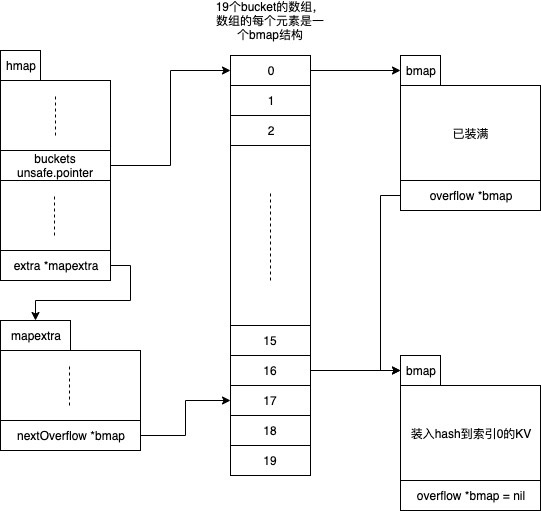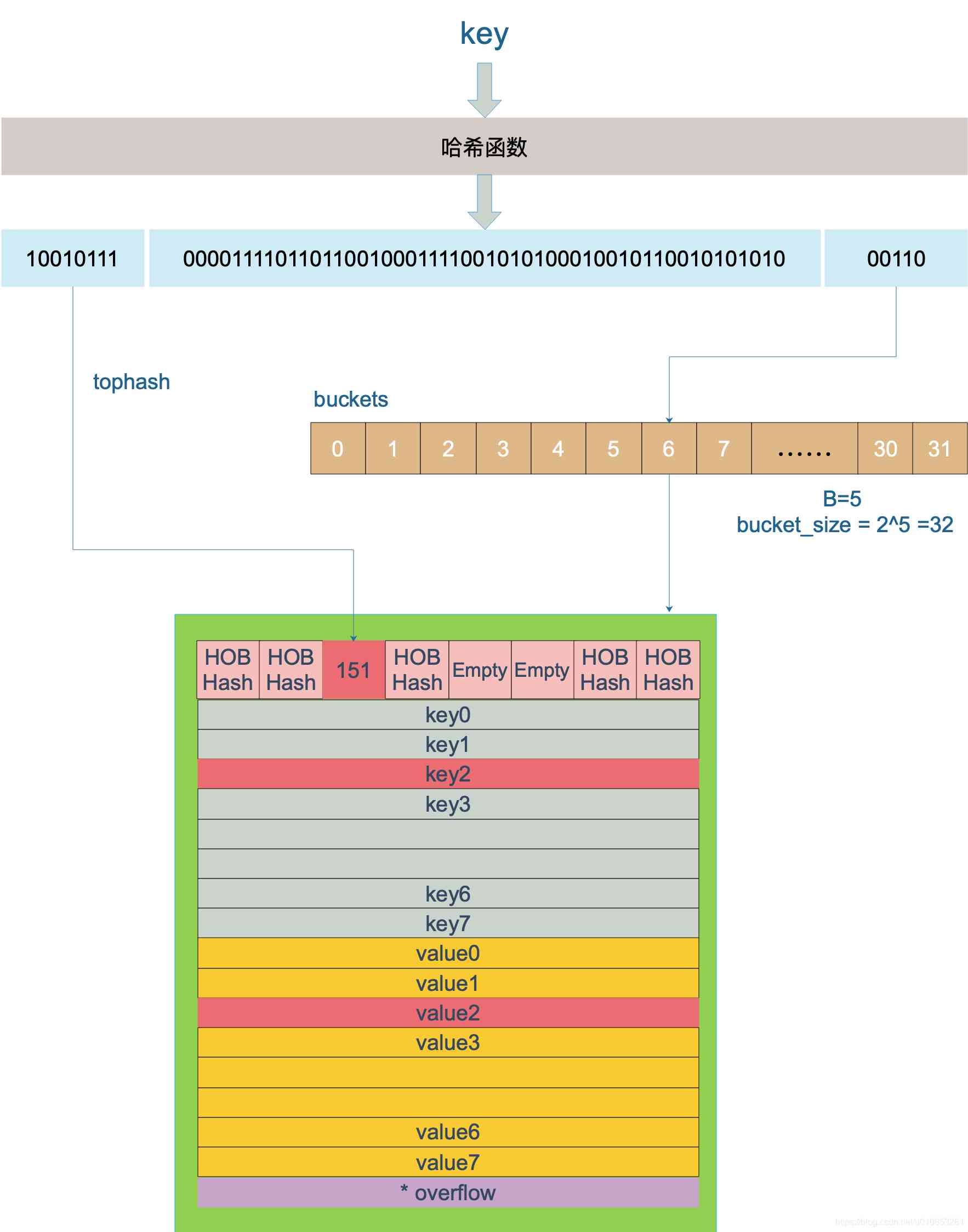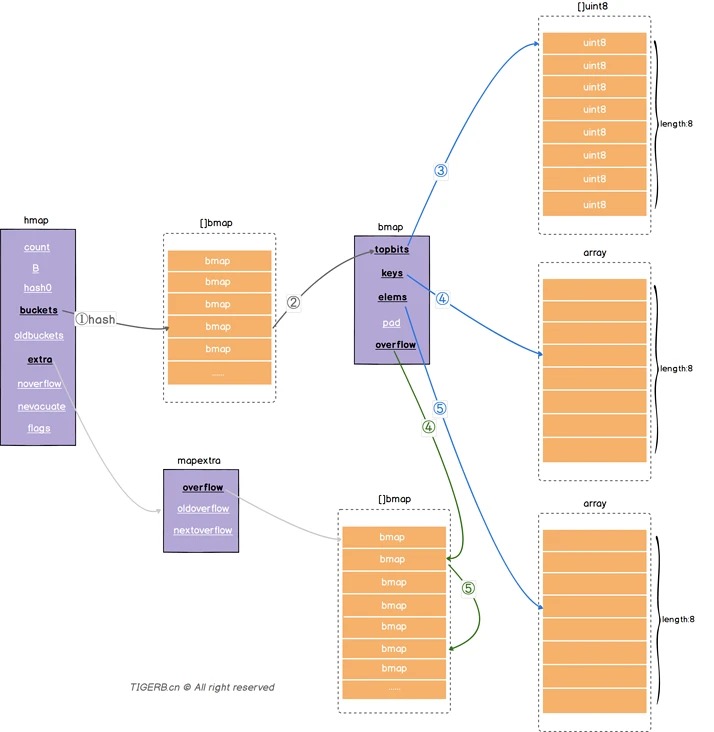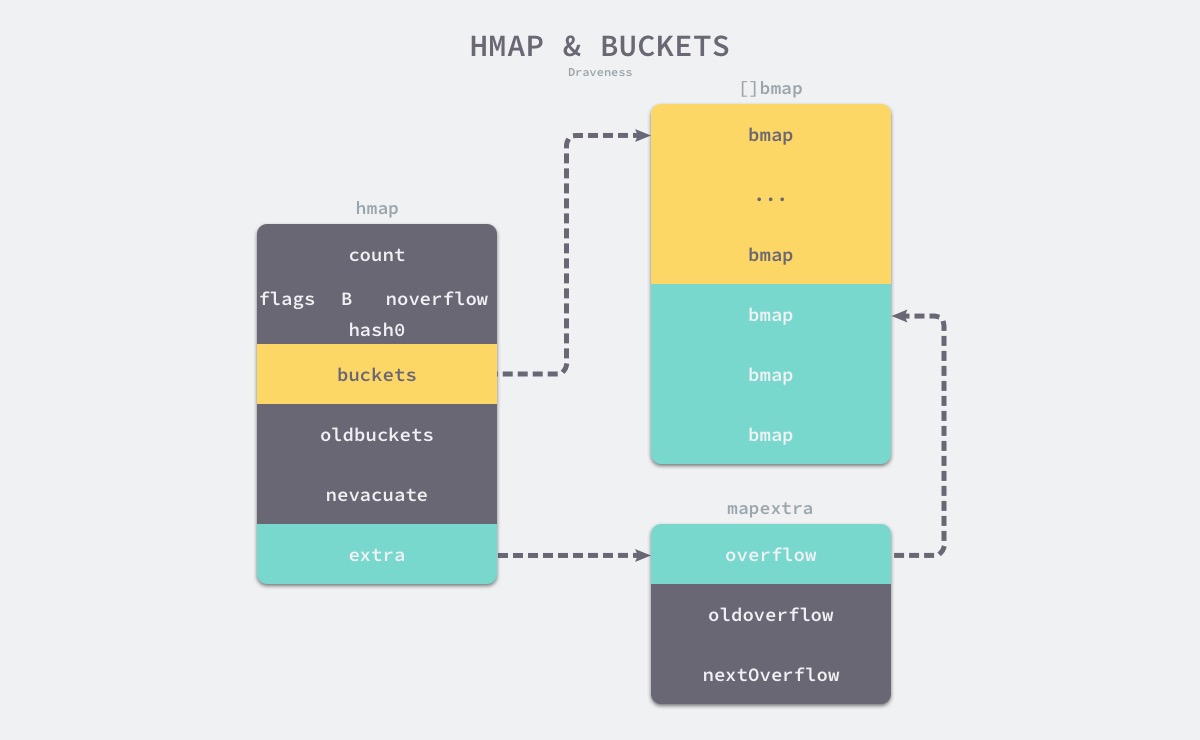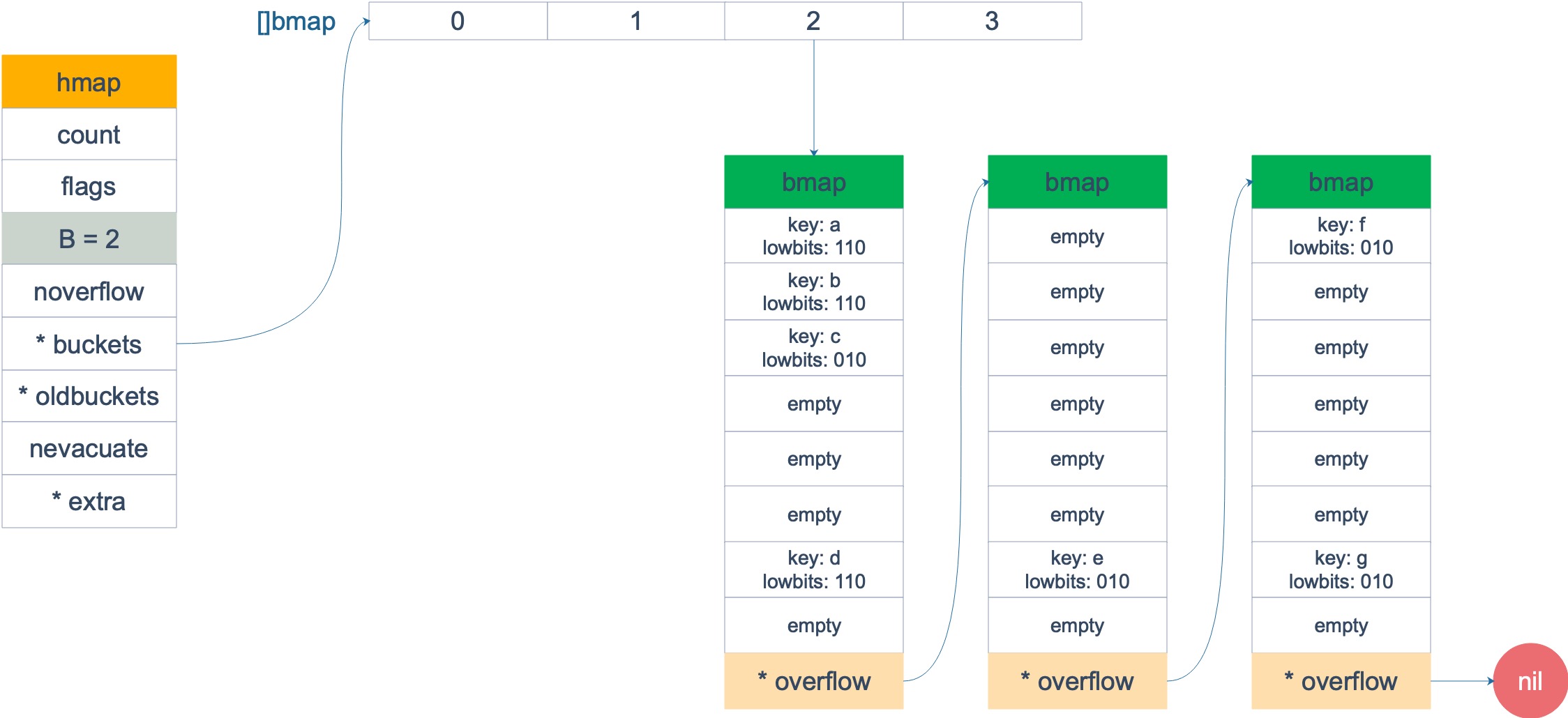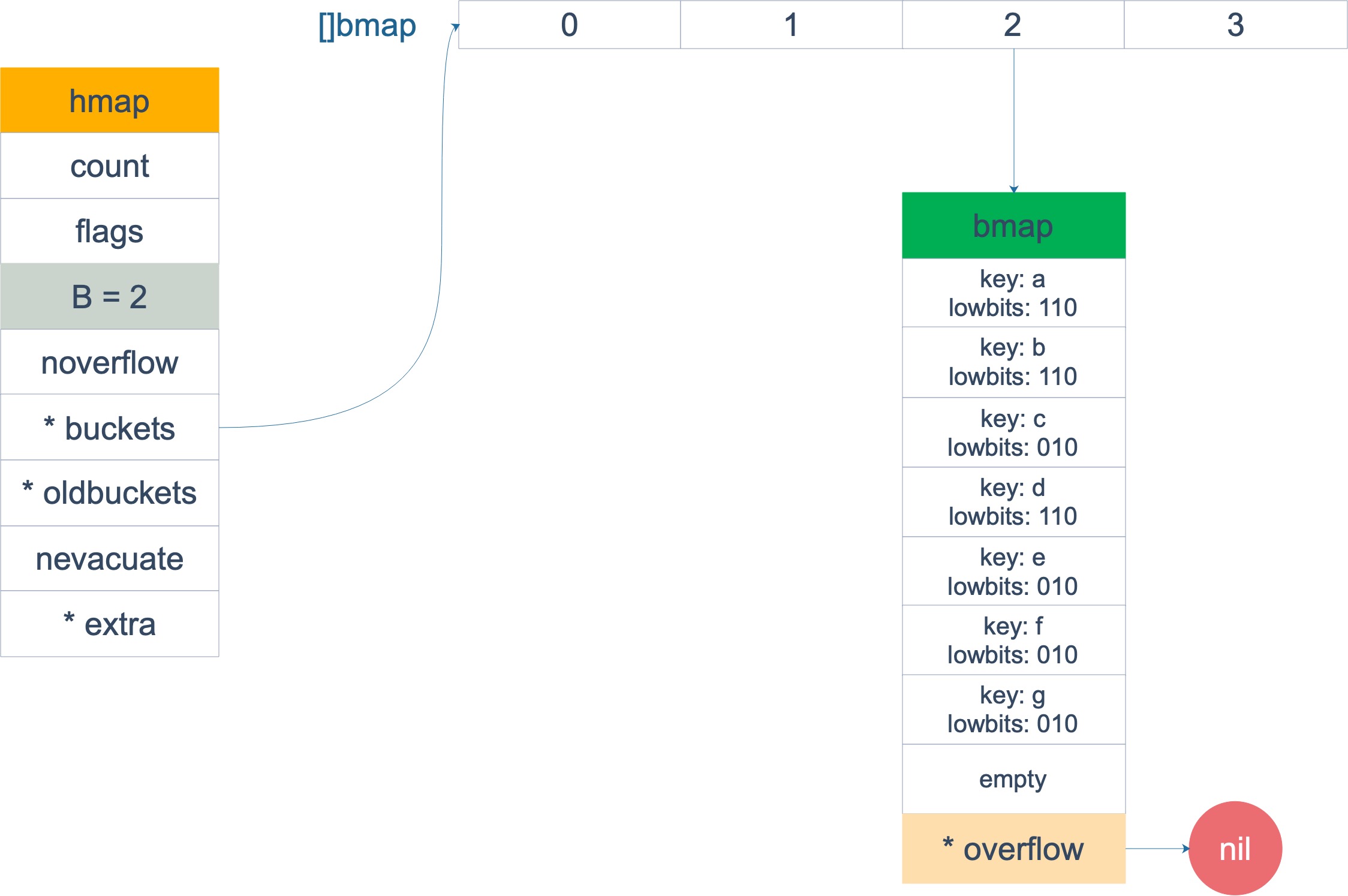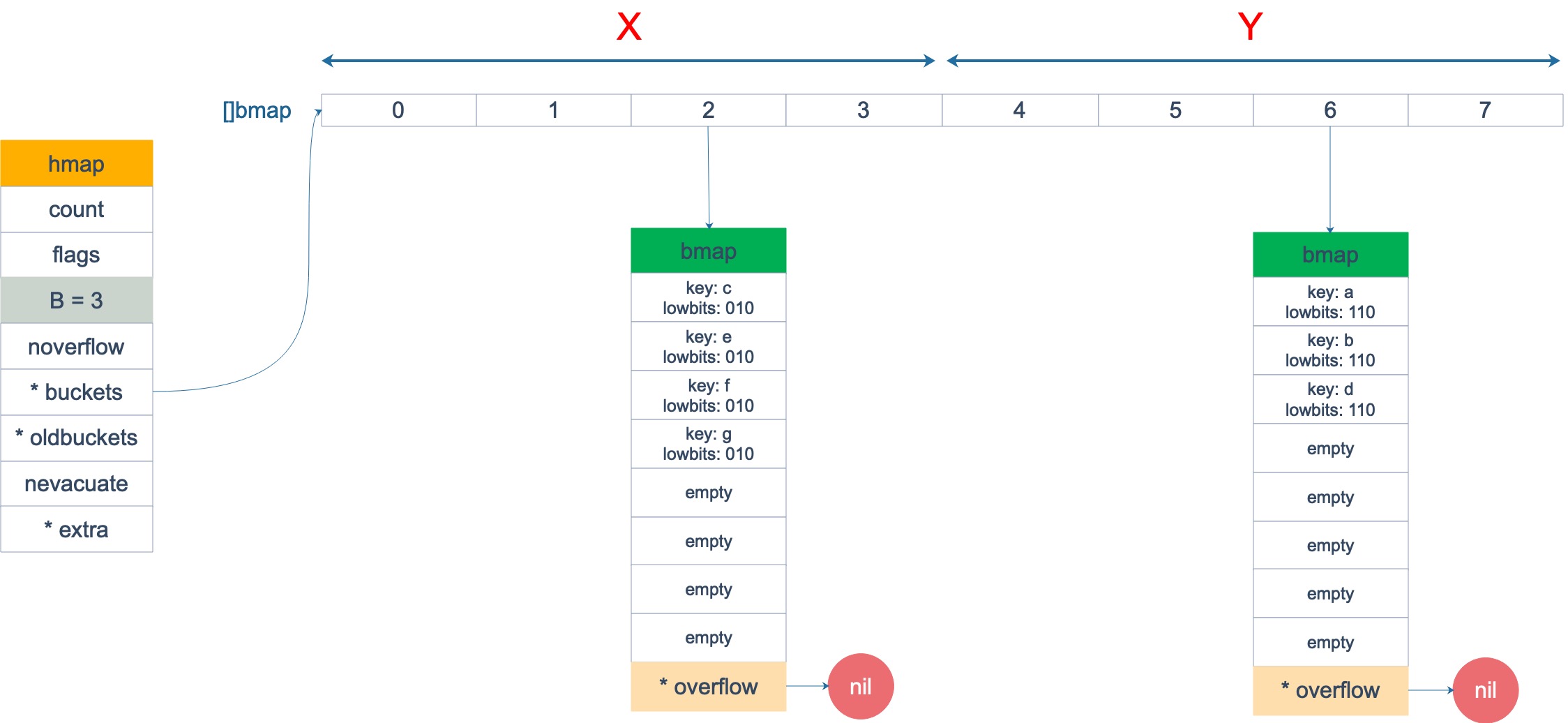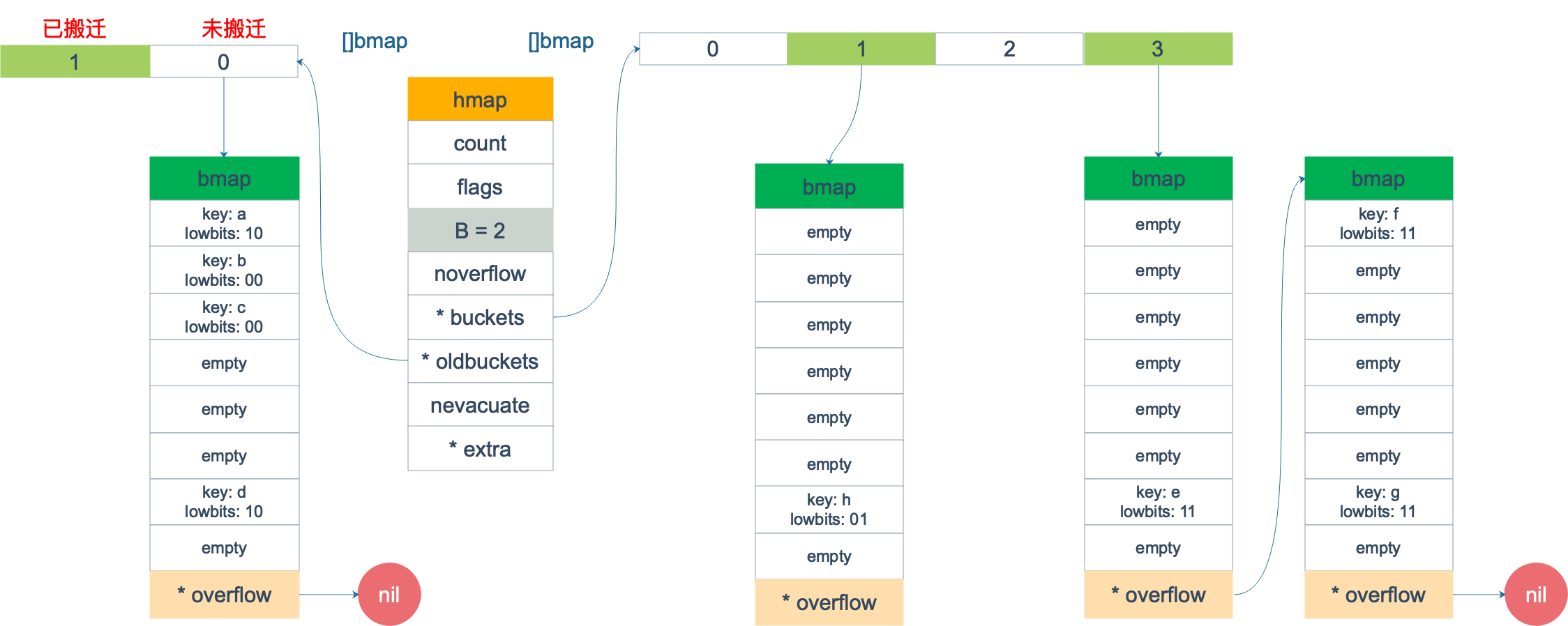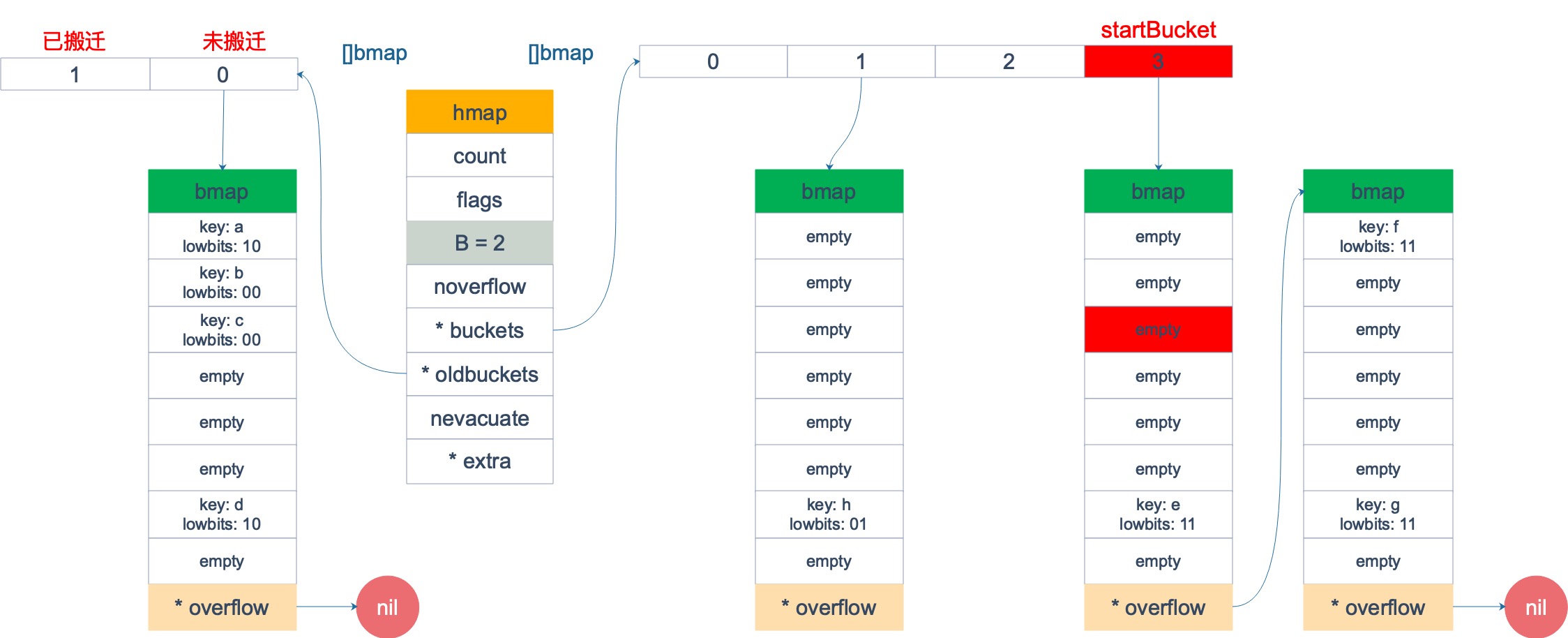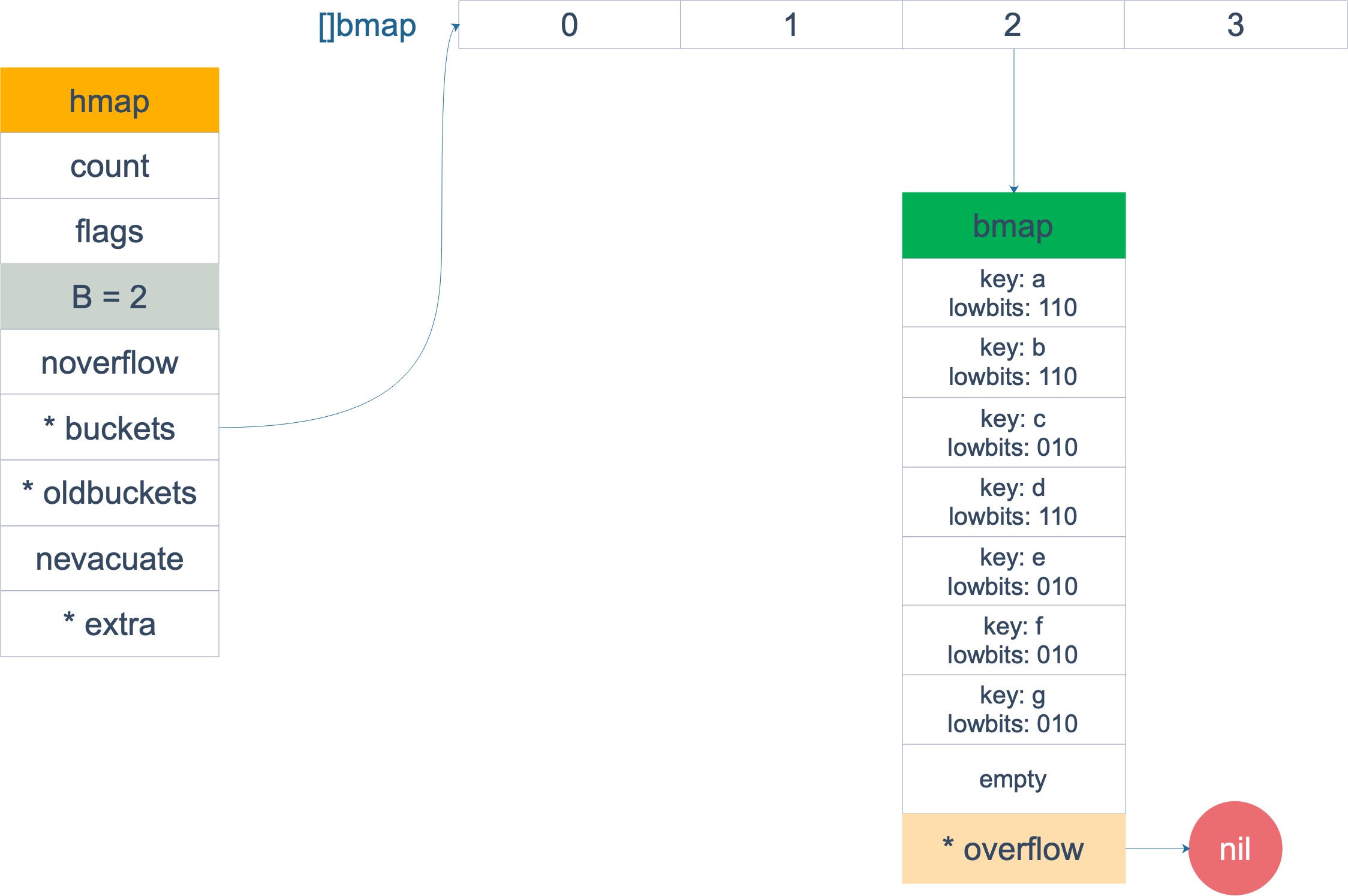你是一个 go 语言专家,我正在学习go,进对我的总结进行评价并指导,给出一些建议, 并给出你修订后的版本
title: “map”
date: 2020-05-14T11:39:03+08:00
draft: false
tags: [“go”,“hash”]
lastmod: 2023-04-18T16:47:26+0800
Map实现原理分析
深度解密Go语言之 map
由浅到深,入门Go语言Map实现原理
golang map底层实现
哈希表
深入理解 Go map:赋值和扩容迁移
深度解密Go语言之 map
map 的实现原理 | Go 程序员面试笔试宝典
遍历过程 | Go 程序员面试笔试宝典
create:
- 字面量 创建:使用常量创建
- 函数创建: make
1
2
3
4
5
6
|
//--1. init
// 1.literal
var a = map[int]int{1:1, 2:2};
// 2. make
var b = make(map[int]int);
|
basic operation:
1
2
3
4
5
|
delete(m,"1")
for k,v := range m
v, ok =m["1"]
|
how
key pointer:
- hash func
- hash collision: 使用改进版的链表法,节点嵌套数组,减少内存创建和回收的cost
1
2
3
4
5
6
7
8
9
10
11
12
13
14
15
16
17
18
19
|
index = hashCode % bucklength
if buckets[index].full == no:
buckets[index].append(key,value)
else:
bucket = buckets[index]
for:
bucket = bucket.next
if bucket == nil:
break;
if bucket.full == no
buckets[index].append(key,value)
break;
|
base structure

simple
1
2
3
4
5
6
|
hmap->[]bucket
bucket:
[]key
[]value
*overflowBucket
|
1
2
3
4
5
6
7
8
9
10
11
12
13
14
15
16
17
18
19
20
21
|
type hmap struct {
count int
flags uint8
B uint8 // 创建 2 ^ B bucket
noverflow uint16 // overflow 的 bucket 近似数
hash0 uint32
buckets unsafe.Pointer // []bmap
oldbuckets unsafe.Poiner
nevacuate uintptr
extra *mapextra
}
// bucket
type bmap struct {
tophash [8]uint8
keys [8]keytype
values [8]valuetype
pad uintptr
overflow uintptr // next bmap
}
|
hash fun

64bit:
- last 2^b bit code to index bucket
- first 8 bit code to index bmap.array
1
2
|
if cpu support aes instruction: hash with aes
use memhash
|
overflow
how:
- linker node contain a array,
- 提前分配好 extra []bmap


access a key
- 遍历数组和overflow
- compare tophash and key
1
2
3
4
5
6
7
8
9
10
11
12
13
14
15
16
17
18
19
20
21
22
23
24
25
26
27
28
29
30
31
32
33
34
|
for {
// 遍历 bucket 的 8 个位置
for i := uintptr(0); i < bucketCnt; i++ {
// tophash 不匹配,继续
if b.tophash[i] != top {
continue
}
// tophash 匹配,定位到 key 的位置
k := add(unsafe.Pointer(b), dataOffset+i*uintptr(t.keysize))
// key 是指针
if t.indirectkey {
// 解引用
k = *((*unsafe.Pointer)(k))
}
// 如果 key 相等
if alg.equal(key, k) {
// 定位到 value 的位置
v := add(unsafe.Pointer(b), dataOffset+bucketCnt*uintptr(t.keysize)+i*uintptr(t.valuesize))
// value 解引用
if t.indirectvalue {
v = *((*unsafe.Pointer)(v))
}
return v
}
}
// bucket 找完(还没找到),继续到 overflow bucket 里找
b = b.overflow(t)
// overflow bucket 也找完了,说明没有目标 key
// 返回零值
if b == nil {
return unsafe.Pointer(&zeroVal[0])
}
}
|
rehash
what: 为了防止查询效率退化(too many overflow),
- 增加bucket ,
- 删除过多的overflow
factor:
1
2
3
|
totalKeys/totalBuckt>=6.5
overflowBucket >= totalbuckets // increase then delete
|
how:
- allocate new bucket
- 渐进式迁移,在更新或者删除触发变迁动作
1
2
3
4
5
6
7
8
9
10
11
12
13
14
15
16
17
18
19
20
21
22
23
24
25
26
27
28
29
30
31
|
func hashGrow(t *maptype, h *hmap) {
// B+1 相当于是原来 2 倍的空间
bigger := uint8(1)
// 对应条件 2
if !overLoadFactor(int64(h.count), h.B) {
// 进行等量的内存扩容,所以 B 不变
bigger = 0
h.flags |= sameSizeGrow
}
// 将老 buckets 挂到 buckets 上
oldbuckets := h.buckets
// 申请新的 buckets 空间
newbuckets, nextOverflow := makeBucketArray(t, h.B+bigger)
flags := h.flags &^ (iterator | oldIterator)
if h.flags&iterator != 0 {
flags |= oldIterator
}
// 提交 grow 的动作
h.B += bigger
h.flags = flags
h.oldbuckets = oldbuckets
h.buckets = newbuckets
// 搬迁进度为 0
h.nevacuate = 0
// overflow buckets 数为 0
h.noverflow = 0
// ……
}
|
1
2
3
4
5
6
7
8
9
10
11
12
13
14
15
16
17
18
19
20
|
func mapdelete(t *maptype, h *hmap, key unsafe.Pointer) {
.....
bucket := hash & bucketMask(h.B)
if h.growing() {
growWork(t, h, bucket)
}
}
func growWork(t *maptype, h *hmap, bucket uintptr) {
// 搬迁正在使用的旧 bucket
evacuate(t, h, bucket&h.oldbucketmask())
// 再搬迁一个 bucket,以加快搬迁进程
if h.growing() {
evacuate(t, h, h.nevacuate)
}
}
func (h *hmap) growing() bool {
return h.oldbuckets != nil
}
|
too many overflow:


factor > 6.5
factor: len(maps)/cap(maps)=6.5; total keys/ total bucket
factor: len(maps)/cap(maps)=6.5, 大致使用65%的bucket容量
why 6.5: 空间和时间(查询效率)权衡,
> 6.5: 冲突太多
< 6.5: 浪费空间
data: 20% overflow, check 4.5 to look up ;
1
2
3
4
5
6
7
8
9
10
11
12
13
14
15
16
17
18
19
|
// Picking loadFactor: too large and we have lots of overflow
// buckets, too small and we waste a lot of space. I wrote
// a simple program to check some stats for different loads:
// (64-bit, 8 byte keys and values)
// loadFactor %overflow bytes/entry hitprobe missprobe
// 4.00 2.13 20.77 3.00 4.00
// 4.50 4.05 17.30 3.25 4.50
// 5.00 6.85 14.77 3.50 5.00
// 5.50 10.55 12.94 3.75 5.50
// 6.00 15.27 11.67 4.00 6.00
// 6.50 20.90 10.79 4.25 6.50
// 7.00 27.14 10.15 4.50 7.00
// 7.50 34.03 9.73 4.75 7.50
// 8.00 41.10 9.40 5.00 8.00
//
// %overflow = percentage of buckets which have an overflow bucket
// bytes/entry = overhead bytes used per key/value pair
// hitprobe = # of entries to check when looking up a present key
// missprobe = # of entries to check when looking up an absent key
|
how:
- bucket * 2
- 重新计算 index;
- lazy move: 当发生(删除,修改,插入) , 一次移动一个bucket


遍历过程以及无序
traverse
generate random start bucket index and offset entry index
1
2
3
4
5
6
7
8
9
|
r := uintptr(fastrand())
if h.B > 31-bucketCntBits {
r += uintptr(fastrand()) << 31
}
// 从哪个 bucket 开始遍历
it.startBucket = r & (uintptr(1)<<h.B - 1)
// 从 bucket 的哪个 key 开始遍历
it.offset = uint8(r >> h.B & (bucketCnt - 1))
|
- 开始遍历, 如果 in 迁移 state, 检测对应的老bucket 是否迁移过
- 未迁移, 则遍历老bucket


unorder
why:
- map不稳定结构,无法保证一致的顺序,rehash后key的顺序就会改变
- go在遍历开始生成随机的遍历起始位置,为避免给新手程序员误解
